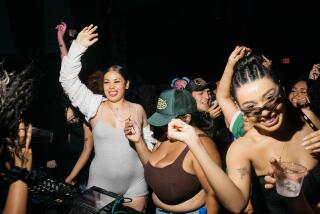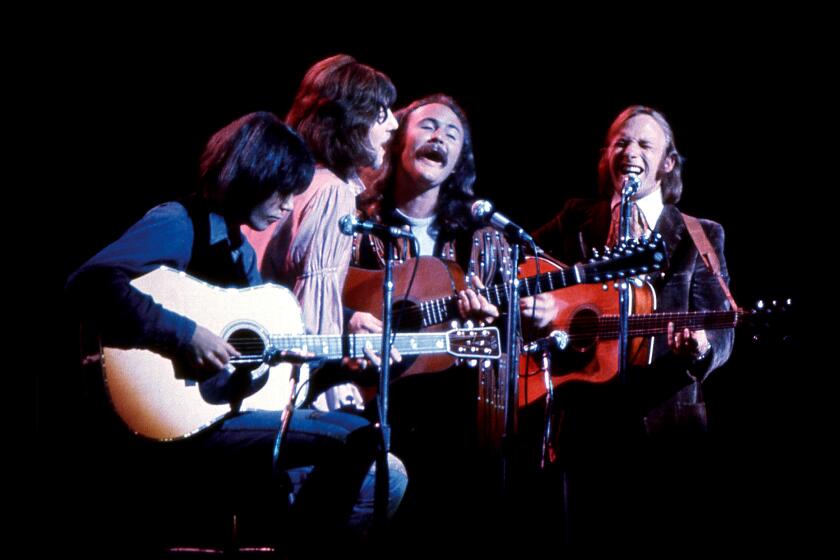The Spin Doctor
- Share via
Most of the new breed of jet-setting club deejays, those turntable tweakers who have become the newest stars in pop, hail from such dance-music capitals as New York and London. But Doc Martin is one darling of the deejay world whose base is a wood-frame home studio at the foot of the Hollywood Hills.
In the last four years, Martin, 31, has gone from being a local underground rave legend to becoming part of an elite echelon of deejays--including Josh Wink and Carl Cox--who travel the world, broadcasting their vinyl vibes to throngs of faithfully ecstatic dance music fans.
Martin (who will not reveal his birth name) has risen to virtuoso status; a master musician in a discipline that involves mixing sometimes minimal vinyl tracks together to create fresh, soul-wrenching sounds.
Known to make appearances in London, New York and Los Angeles on the same weekend, he has held prestigious “residencies”--regular gigs--at New York’s king of clubs, Twilo, and the U.K.’s own super-club, Cream in Liverpool. England’s prestigious Muzik magazine calls him “one of America’s finest.”
And as dance music ascends in America, Martin finally finds his star rising at home.
These days he spends much of his time in his studio, surrounded by what he estimates is 20,000 records, mostly underground 12-inch dance singles. He’s been making original recordings for Moonshine Music, some of which have reached the Top 40 on Billboard magazine’s Club Play charts.
Martin’s last project, 1996’s “Unlock the House” album, received overwhelming praise in the dance music press. It was his third “mix CD,” a compilation of hand-picked singles mixed in nonstop club fashion. Martin also spins a live, three-hour mix show, “Sounds You Can Feel,” Fridays at midnight on Groove Radio (103.1 FM).
“Not only does he regularly devastate dance floors in prestigious clubs like New York’s Twilo to Liverpool’s Cream, but he can also send a crowd of ravers into ecstasy,” says Darren Ressler, editor of the U.S. edition of Mixmag, a dance music journal. “That’s rare these days in a scene where there are sizable walls between the two ends of the dance music spectrum.”
Oversize and boyish, Martin is an enthusiastic professor, often holding court behind the decks at Melrose’s Beat Non Stop deejay shop. He chuckles with enthusiasm as the latest shipment of vinyl is unboxed. And he graciously dispenses the 411 on the upcoming weekend’s party circuit.
“A lot of people are treating deejays like rock stars--dressing rooms, Jack Daniel’s, girls on each arm and top billing,” he says. “But this is not rock ‘n’ roll.
“It’s a powerful thing, music, regardless if you’re playing it on a guitar, a synthesizer or turntables.”
Club deejays have become the freshest influence in pop music, injecting a dance-floor aesthetic by recording and remixing records (for artists such as Michael Jackson and Tori Amos) while traveling the world’s clubs for fees of up to $2,000 or more a night.
While most star deejays are one-note musicians, sticking to a single subgenre of sound (with an ever-changing vernacular--Goa trance, hardbag, epic house . . .), Martin’s live deejay sets are all over the place.
“In this age of specialized formats among deejays, what sets Doc Martin apart from his peers is his ability to spin everything from deep house to trance to classics,” says Ressler of Mixmag. “Doc loves deejaying and loves music . . .”
Borrowing acidic synths from techno, trippy melodies from trance and fat kick drums from house, Martin dips into his record box the way an impressionist uses his palette, creating dreamy aural landscapes that capture subconscious emotion.
He uses three turntables and thus finds himself in the mix (mixing one song over another) as often as not. He twists knobs on his mixing console like a music studio engineer to get the most out of an artist’s tracks. Fans come away from Martin’s sets buzzing phrases like “deep” and “soulful.”
“I’ve just always wanted to put out positive vibrations,” he says while auditioning vinyl on one of three chrome-topped turntables in his studio room. “There’s a lot of love in it. I spend a lot of time in this room practicing with records.
“My style is using what I call vibratory energy,” he says. “It’s when a spark starts off the dance floor . . . the whole place explodes. It’s important to get the crowd on your side.”
Martin--of Armenian, Spanish and Cherokee descent--grew up in bohemian San Francisco neighborhoods such as the Lower Haight, the product of a single mother who worked as a hairdresser when she wasn’t singing back-up for rock groups including the Jefferson Airplane. “I was brought up on Motown and rock,” Martin says.
He got his moniker as a youth enthralled with the Dr. Martens-wearing mod and ska scenesters of the early ‘80s. He became a deejay by accident, cuing up a record for a deejay friend on a bathroom break. He accidentally scratched the record. The club’s owner thought he was mixing hip-hop style and offered him a job. That was 11 years ago.
After helping to spread the post-disco sound of “house” and “acid house” in San Francisco, he moved to L.A. in 1990. “It was time for a change,” he says.
Martin became the focal deejay for America’s first wave of all-night dance parties known as raves, which had already broken in Europe.
“I knew if it would catch on nationwide, there would need to be a major city behind it,” he says. “L.A. became it, and it was good to be a part of that.”
By 1992, raving had reached a boiling point in L.A., with gangsters creating flash points of violence and crowds growing to unruly proportions. The riots of ’92 also scared off the suburban flow of youth.
Martin became the arbiter of the next wave of L.A. clubbing--underground “after-hours” events often held in inner-city spaces and continuing into brunch-time. He was the resident deejay at the club that started the trend, Flammable Liquid, a 1,000-person roving party that people are still talking about.
“The hype about raves started getting crazy,” he says. “So it had to go back underground.”
Around 1994 Martin met an Englishman who invited him to come spin in the U.K. Soon, Martin was juggling commitments at clubs in L.A. (Logic), Irvine (Metropolis) and in the north of England (Cream, Back to Basics).
“There’s a lot of interest in Europe as far as getting me signed to a record deal,” he says. “But it’s got to be the right thing--something where I can do what I want to do.”
These days he also finds himself just as often in Tokyo, Hong Kong, Sydney. But he’s in L.A. to stay, whether we treat him like a pauper or a star.
“There’s no place like the West Coast,” he says. “There’s just a happy vibe out here.”
More to Read
The biggest entertainment stories
Get our big stories about Hollywood, film, television, music, arts, culture and more right in your inbox as soon as they publish.
You may occasionally receive promotional content from the Los Angeles Times.










